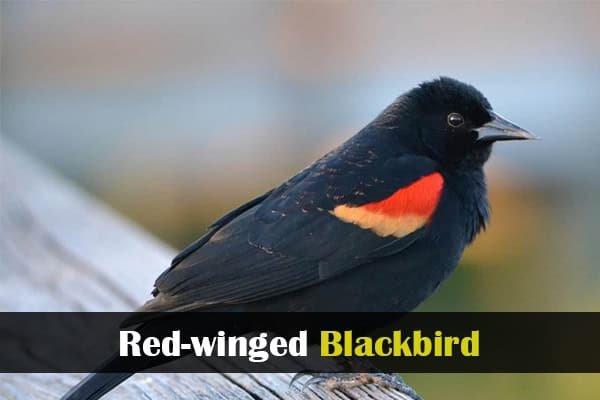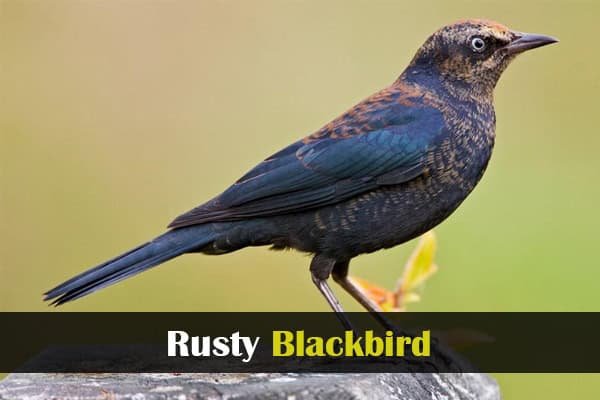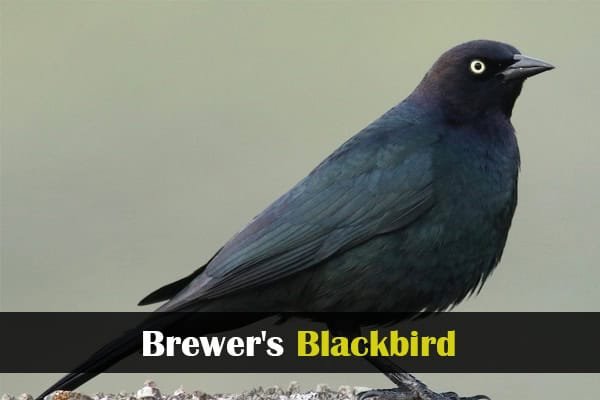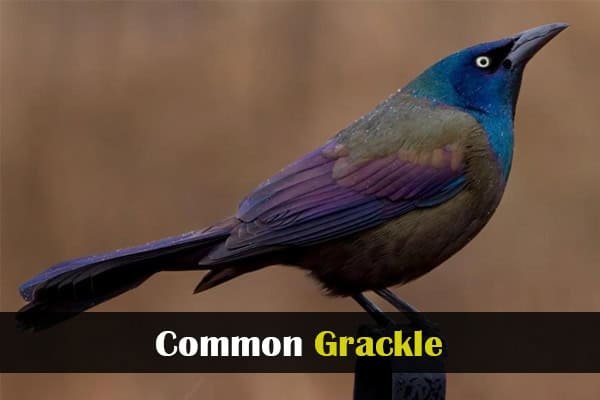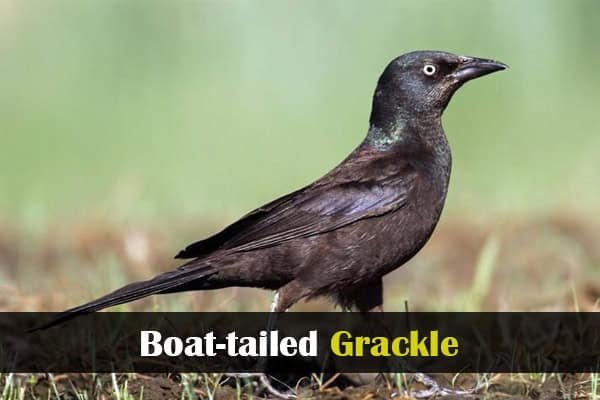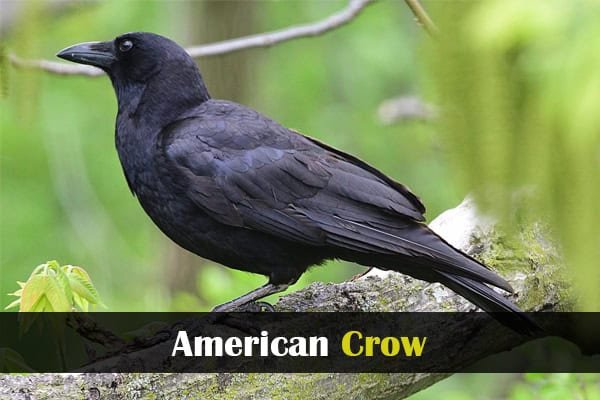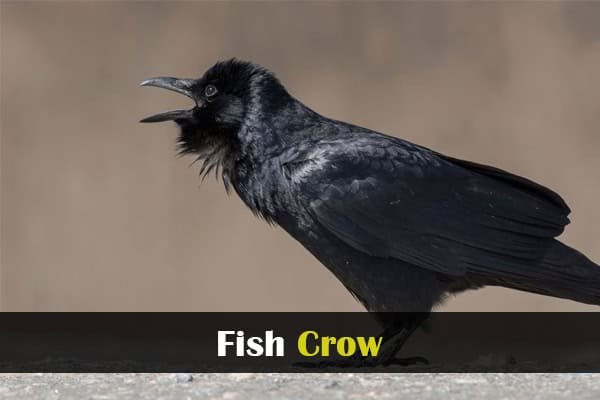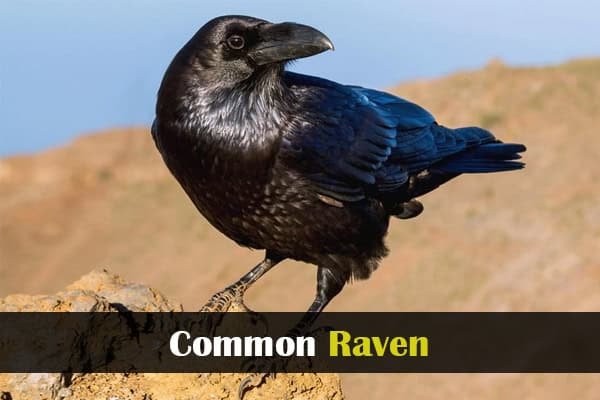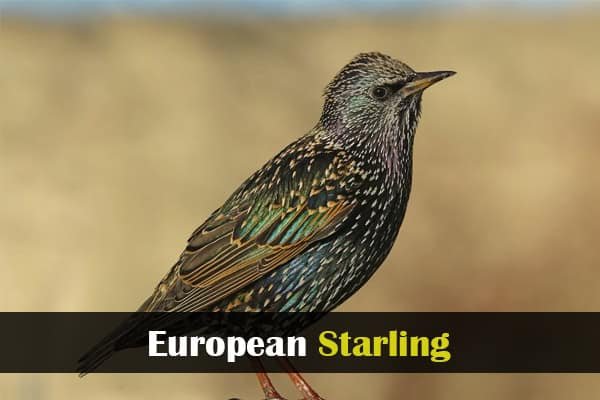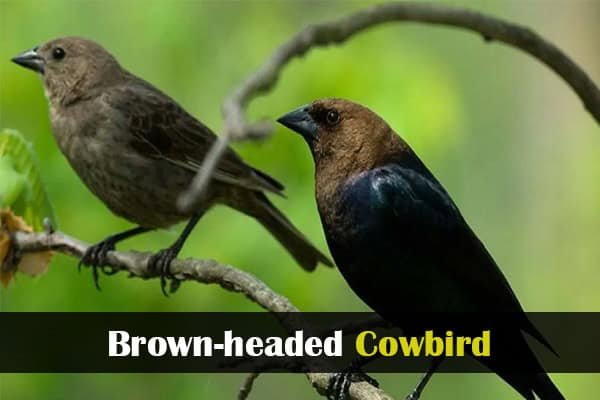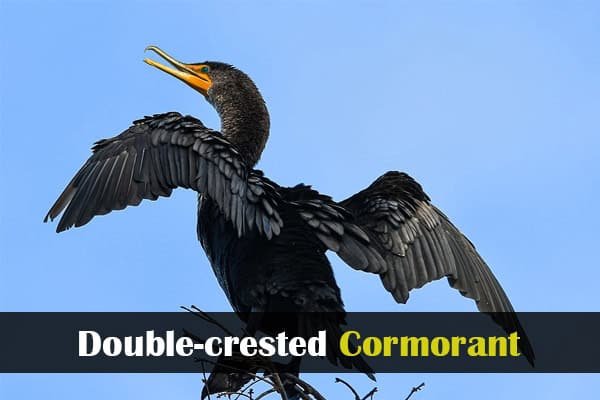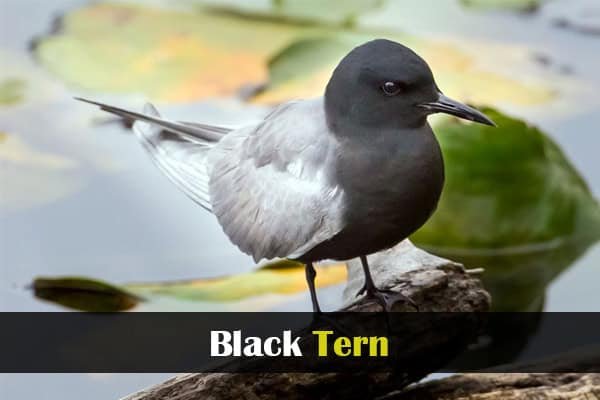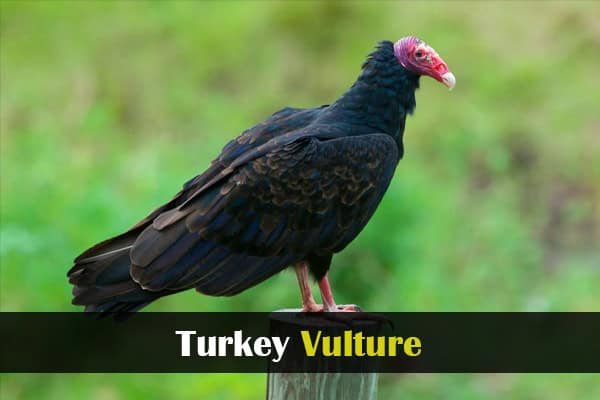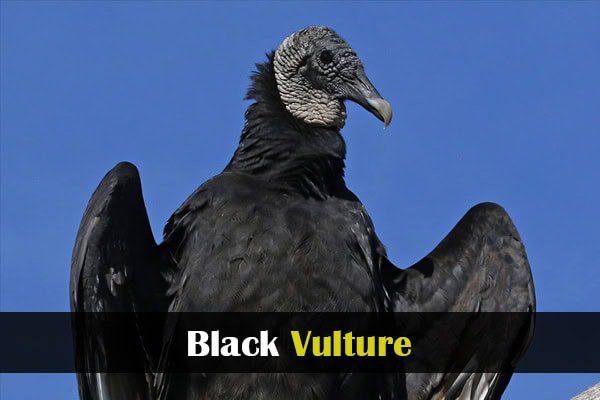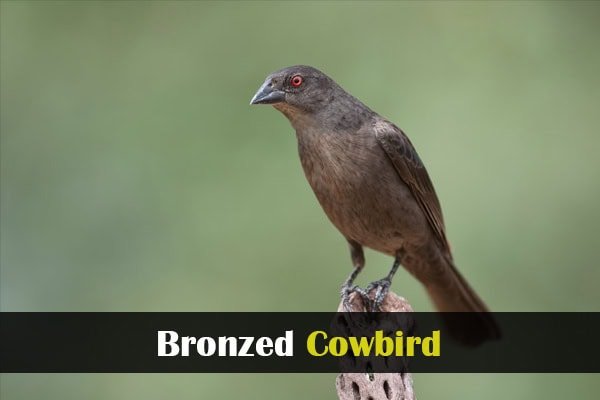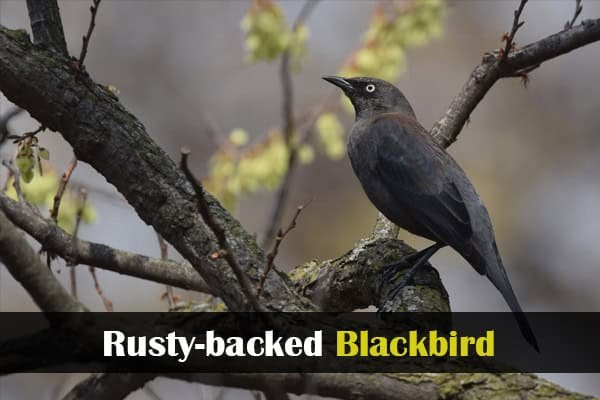Have you ever wondered about the black birds you might see in Michigan wetlands or forests? Michigan’s varied landscapes are perfect for many bird species, including those with shiny black feathers.
Michigan’s wetlands, forests, and fields are great for bird watching. You’ll find interesting birds like red-winged blackbirds, Crows, which often gather in big flocks, especially during the breeding season, and grackles. These birds stand out because of their unique looks and actions.
These birds are important in the ecosystem. They help control pests and spread seeds. Outside in Michigan, you’ll probably see many black birds. This article will help you know which ones you might see.
Most Common Small Black Birds Live in Michigan
- Red-winged Blackbird
- Rusty Blackbird
- Brewer’s Blackbird
- Common Grackle
- Boat-tailed Grackle
- American Crow
- Fish Crow
- Common Raven
- European Starling
- Brown-headed Cowbird
- Double-crested Cormorant
- Black Tern
- Turkey Vulture
Fascinating World of Black Birds in Michigan
Michigan is a haven for bird lovers, with various black birds. The state’s different landscapes support many black bird species. This makes Michigan a great place for birdwatching.
Michigan’s Diverse Habitats for Black Birds
The state’s wetlands, such as marshes and swamps, are perfect for many black birds. Forests, both deciduous and coniferous, also offer homes for these birds.
Urban areas, with their parks and gardens, also attract black birds, which means they are often seen in cities and towns.
Seasonal Patterns and Migration
Black birds in Michigan show different patterns and migration behaviors. Some go to warmer places in winter, while others stay all year.
Knowing these patterns helps us appreciate black birds in Michigan. As seasons change, food and weather affect their migrations.
How to Identify Black Birds
To spot black birds in Michigan, you must know their key features. Look at their plumage, beak shape, and size. These details help tell different species apart.
Key Physical Characteristics
Black birds often have glossy feathers that shine. Also, their beak shape and size give clues. Some have strong, conical beaks, while others have longer, pointed ones.
| Characteristic | Description |
| Plumage | Glossy or matte black feathers |
| Beak Shape | Conical, pointed, or broad |
| Size | Varies from small to large |
Male vs. Female Differences in Plumage
Black birds have different looks. Males often have brighter plumage, while females have duller or more mixed feathers, which makes them less noticeable.
True Blackbirds
In Michigan’s wetlands and fields, you’ll find several true blackbird species. They stand out with their unique traits and actions. This makes them very interesting to study.
1. Red-winged Blackbird
- Scientific Name: Agelaius phoeniceus
- Size: 6.7–9.1 inches (17–23 cm)
- Wingspan: 12.2–15.8 inches (31–40 cm)
- Weight: 1.1–2.7 oz (32–77 g)
- Diet: Insects, seeds, grains
- Lifespan: Up to 15 years in the wild
The Red-winged Blackbird is easy to spot in Michigan. Its wings have bright red and yellow patches. The male has glossy black feathers and a red and yellow epaulet for signaling.
2. Rusty Blackbird
- Scientific Name: Euphagus carolinus
- Size: 8.3–9.8 inches (21–25 cm)
- Wingspan: 14.6 inches (37 cm)
- Weight: 1.7–2.8 oz (47–80 g)
- Diet: Insects, small invertebrates, seeds, and some plant matter
- Lifespan: Up to 8 years (average 2–3 years in the wild)
The Rusty Blackbird is another species in Michigan. It turns rusty-colored in the non-breeding season. This bird lives in wooded wetlands and migrates.
3. Brewer’s Blackbird
- Scientific Name: Euphagus cyanocephalus
- Size: 8.3–9.8 inches (21–25 cm)
- Wingspan: 14.6 inches (37 cm)
- Weight: 1.8–3.0 oz (50–85 g)
- Diet: Insects, seeds, grains, berries, and occasional human food scraps
- Lifespan: Up to 12 years (average around 6 years in the wild)
Brewer’s Blackbird has glossy black feathers and pale yellow eyes. It’s seen in open areas like fields and backyards. This bird forages on the ground for insects and seeds.
True blackbirds like the Red-winged, Rusty, and Brewer’s add to Michigan’s bird diversity. Each species has its own look, behavior, and home. They’re a delight for birdwatchers and scientists.
Grackles and Their Distinctive Features
Have you seen grackles with their shiny feathers and long tails? These black birds are common in Michigan and show up at specific times. They stand out with their glossy feathers and unique traits.
Grackles have feathers that shine in the light, making them look like they’re covered in jewels. Their long tails are special too. They use these tails to show off and mark their territory.
4. Common Grackle
- Scientific Name: Quiscalus quiscula
- Size: 11–13.4 inches (28–34 cm)
- Wingspan: 14–18.1 inches (36–46 cm)
- Weight: 2.6–5 oz (74–142 g)
- Diet: Insects, seeds, grains, fruit, small animals, and garbage
- Lifespan: Up to 22 years (average around 6 years in the wild)
In Michigan, you’ll often see the Common Grackle. They have shiny black feathers and a unique tail. Their feathers also have a purple or blue glow, mainly on their heads and backs.
These birds are smart and can adapt well. You’ll find them looking for food in both cities and countryside.
| Feature | Description |
| Plumage | Glossy black with purple or blue sheen |
| Tail feathers can be seen fanned out when the bird perches. | Keel-shaped, long |
| Eyes | Yellow |
5. Boat-tailed Grackle
- Scientific Name: Quiscalus major
- Size: 10–17 inches (25–43 cm)
- Wingspan: About 15–20 inches (38–51 cm)
- Weight: 3.0–8.8 oz (85–250 g)
- Diet: Insects, crustaceans, seeds, grains, small fish, and human scraps
- Lifespan: Up to 12 years (average around 5–7 years in the wild)
The Boat-tailed Grackle is easy to spot because of its long, wedge-shaped tail. Their feathers shimmer in the light, showing off purple or blue colors. You’ll find them near the coast and in wetlands, where they hunt for insects and small creatures.
| Feature | Description |
| Tail | Long, wedge-shaped |
| Plumage | Iridescent, purple or blue sheen |
| Habitat | Coastal areas, wetlands |
Crows and Ravens
The world of crows and ravens is fascinating. These birds are key to Michigan’s ecosystem and known for their clever nature. They are recognized by their distinctive calls and problem-solving abilities, making them a captivating subject for observation.
6. American Crow
- Scientific Name: Corvus brachyrhynchos
- Size: 15.8–20.9 inches (40–53 cm)
- Wingspan: 33.5–39.4 inches (85–100 cm)
- Weight: 11.2–21.9 oz (316–620 g)
- Diet: Omnivorous – insects, small animals, seeds, fruits, carrion, garbage
- Lifespan: Up to 17 years in the wild (over 30 years in captivity)
The American Crow is a common sight in Michigan. It has glossy black feathers and a strong beak. These birds are highly adaptable and can be found in various habitats from forests to urban areas.
Their intelligence is showcased through complex social behaviors and innovative foraging strategies.
7. Fish Crow
- Scientific Name: Corvus ossifragus
- Size: 14–16 inches (36–41 cm)
- Wingspan: 33 inches (84 cm)
- Weight: 7.3–10.6 oz (208–300 g)
- Diet: Omnivorous – fish, insects, crustaceans, eggs, fruits, garbage
- Lifespan: Up to 14 years (average around 6–8 years in the wild)
The Fish Crow is another species found in Michigan. It is known for its nasal call, which distinguishes it from other crow species. With a more restricted diet, the Fish Crow prefers fish and other aquatic food sources.
Their presence is often associated with wetland areas.
Related: White Birds In Michigan
8. Common Raven
- Scientific Name: Corvus corax
- Size: 22–27 inches (56–69 cm)
- Wingspan: 45.7–46.5 inches (116–118 cm)
- Weight: 24.3–57.3 oz (689–1,625 g)
- Diet: Omnivorous – small animals, insects, carrion, seeds, fruit, garbage
- Lifespan: Up to 21 years in the wild (over 40 years in captivity)
The Common Raven is a large, intelligent bird with a distinctive wedge-shaped tail. In Michigan, they are less common than crows but are notable for their presence in more remote, wilderness areas. Ravens are known for their problem-solving abilities and complex vocalizations, making them a subject of interest among bird enthusiasts.
| Characteristics | American Crow | Fish Crow | Common Raven |
| Distinctive Feature | Glossy black feathers | Nasal call | Wedge-shaped tail |
| Habitat | Varied, including urban areas | Wetlands | Remote wilderness |
| Diet | Omnivorous | Aquatic food sources | Varied, including carrion |
Starlings and Cowbirds
The starlings and cowbirds are fascinating black birds in Michigan. They are known for their striking features and intriguing habits. You can see them in various places, from cities to countryside.
9. European Starling
- Scientific Name: Sturnus vulgaris
- Size: 7.9–9.1 inches (20–23 cm)
- Wingspan: 12.2–15.8 inches (31–40 cm)
- Weight: 2.1–3.4 oz (60–96 g)
- Diet: Insects, fruits, seeds, grains, and human food scraps
- Lifespan: Up to 15 years (average 2–5 years in the wild)
The European Starling is a common sight in Michigan. It’s known for its shiny black feathers and unique calls. These birds adapt well to different environments.
European starlings have iridescent feathers that shine purple and green in the right light. They also have complex social behaviors and often form large flocks, which can be both captivating and overwhelming.
10. Brown-headed Cowbird
- Scientific Name: Molothrus ater
- Size: 6.3–8.7 inches (16–22 cm)
- Wingspan: 12.6–15.0 inches (32–38 cm)
- Weight: 1.3–1.8 oz (42–51 g)
- Diet: Seeds, insects, and grains
- Lifespan: Up to 16 years (average 4–8 years in the wild)
The Brown-headed Cowbird is another notable black bird in Michigan. It’s known for its unique way of reproducing called brood parasitism. Instead of building its own nest, it lays its eggs in other birds’ nests.
This behavior can harm the host species, which may already be vulnerable or endangered. Watching these birds helps us understand their interesting habits and the complex relationships in Michigan’s bird world.
Water-Loving Black Birds
Water-loving black birds are quite interesting and found in Michigan’s wetlands. They live in and around water, showing special traits for aquatic life.
11. Double-crested Cormorant
- Scientific Name: Phalacrocorax auritus
- Size: 28–35 inches (71–89 cm)
- Wingspan: 46–48 inches (117–122 cm)
- Weight: 3.3–5.5 lbs (1.5–2.5 kg)
- Diet: Mostly fish, occasionally amphibians and crustaceans
- Lifespan: Up to 15 years in the wild
The Double-crested Cormorant is big and black, with an orange beak and long neck. It lives in Michigan’s lakes and rivers, eating fish and other water creatures. They dive deep, perfect for their water home. You’ll see them drying their wings on rocks or trees.
12. Black Tern
- Scientific Name: Chlidonias niger
- Size: 9–11 inches (23–28 cm)
- Wingspan: 24–26 inches (61–66 cm)
- Weight: 2.6–3.5 oz (75–100 g)
- Diet: Small fish, aquatic insects, and crustaceans
- Lifespan: Up to 10 years in the wild
The Black Tern is medium-sized, known for its quick flight and unique sounds. It nests in Michigan’s wetlands, hunting insects and small fish. Its dark color and fast movements are exciting to watch. They like shallow waters and marshy spots.
Scavengers with Black Plumage
In Michigan, some black birds are known for eating carrion and dead animals. They help keep the ecosystem balanced by getting rid of dead matter. This stops diseases from spreading.
13. Turkey Vulture
- Scientific Name: Cathartes aura
- Size: 25–32 inches (64–81 cm)
- Wingspan: 63–72 inches (160–183 cm)
- Weight: 2.6–5.3 lbs (1.2–2.4 kg)
- Diet: Carrion (dead animals)
- Lifespan: Up to 16 years in the wild
The Turkey Vulture is a common sight in Michigan. It has black feathers and a red head. It can have a wingspan of up to 6 feet, making it a stunning sight.
These birds use their strong sense of smell to find food. They soar high in the sky, using warm air currents to stay aloft with little effort.
14. Black Vulture
- Scientific Name: Coragyps atratus
- Size: 22–29 inches (56–74 cm)
- Wingspan: 52–60 inches (132–152 cm)
- Weight: 3.3–5.5 lbs (1.5–2.5 kg)
- Diet: Carrion (dead animals)
- Lifespan: Up to 15 years in the wild
The Black Vulture is less common in Michigan but just as important. It has all black feathers and a sharp beak. These birds are very social and often seen together.
They can be quite aggressive when they find food. This shows how important they are to the ecosystem.
| Characteristics | Turkey Vulture | Black Vulture |
| Plumage | Black with brownish hue | Entirely black |
| Head Color | Red | Black |
| Beak | Pinkish, relatively weak | Sharp, hooked |
Both the Turkey Vulture and Black Vulture are key to the ecosystem. They act as nature’s cleanup crew. Their work helps keep the environment healthy by removing dead animals and stopping disease spread.
Other Notable Black Birds
As you explore the world of black birds in Michigan, you’ll find many interesting species. These birds have unique traits that set them apart from others.
15. Bronzed Cowbird
- Scientific Name: Molothrus aeneus
- Size: 7.1–8.3 inches (18–21 cm)
- Wingspan: About 13.8 inches (35 cm)
- Weight: 2.1–2.5 oz (60–70 g)
- Diet: Seeds, insects, and grains
- Lifespan: Around 8 years in the wild
The Bronzed Cowbird has shiny black feathers that sometimes look bronze. It’s known for its special calls and behaviors. This makes it a favorite among bird watchers. One of its key distinctive characteristics is how well it adapts to different places.
16. Rusty-backed Blackbird
- Scientific Name: Leistes superciliaris
- Size: About 7.9 inches (20 cm)
- Wingspan: Not well documented, but estimated around 12 inches (30 cm)
- Weight: Approximately 1.6 oz (45 g)
- Diet: Seeds, insects, and small invertebrates
- Lifespan: Data limited; likely similar to related blackbirds, around 5–8 years in the wild
The Rusty-backed Blackbird is less common in Michigan but just as fascinating. It has a rusty back that contrasts with its black feathers. Bird watchers enjoy seeing its unique look and actions.
| Species | Distinctive Feature | Habitat |
| Bronzed Cowbird | Glossy black feathers with bronze sheen | Varied environments |
| Rusty-backed Blackbird | Rusty-colored back | Wetlands and open areas |
What to Look for in Flight
Watching black birds in flight is amazing. You’ll see their wing patterns and flight styles. It’s a great way to learn about their behavior and traits.
Wing Patterns and Flight Styles
Each black bird species has its own flight style. For example, grackles fly fast and straight. Crows, on the other hand, soar high. Their wing patterns also differ, with some having stiffer wingbeats.
Flock Formations
Black birds often fly together in flock formations. These can be either loose or tight groups. Watching these flock formations helps us understand their social behavior.
By focusing on these flight aspects, you can improve your bird-watching skills. It will also help you appreciate these birds more.
Where to Find Black Birds in Michigan
If you’re looking to spot black birds in Michigan, you’ll find them in a range of environments. This includes urban centers and natural habitats.
Urban and Suburban Locations
Black birds are common in urban and suburban areas. They can be seen foraging for food in parks, gardens, and backyards. Cities like Detroit and Grand Rapids offer many spots to observe these birds.
Wetlands and Marshes
Wetlands and marshes are ideal habitats for many black bird species. Areas like the Shiawassee National Wildlife Refuge are known for their rich birdlife. This includes various black bird species.
Woodlands and Forests
Michigan’s woodlands and forests also host a variety of black bird species. The state’s many parks and forests, such as Porcupine Mountains Wilderness State Park, provide a habitat. Birds like the American Crow and Common Grackle can be found here.
Conclusion
Michigan is home to many black bird species, each unique in its own way. These birds add beauty to our world. The state’s different places, like cities, wetlands, and forests, are home to many black birds.
When you go outside in Michigan, you might see birds like the Red-winged Blackbird, Common Grackle, and American Crow. It’s important to protect their homes and fight against environmental problems. This way, we can keep Michigan’s black birds safe for the future.
Learning about these birds and helping conservation efforts can make a big difference. You can help protect black birds in Michigan for years to come.

